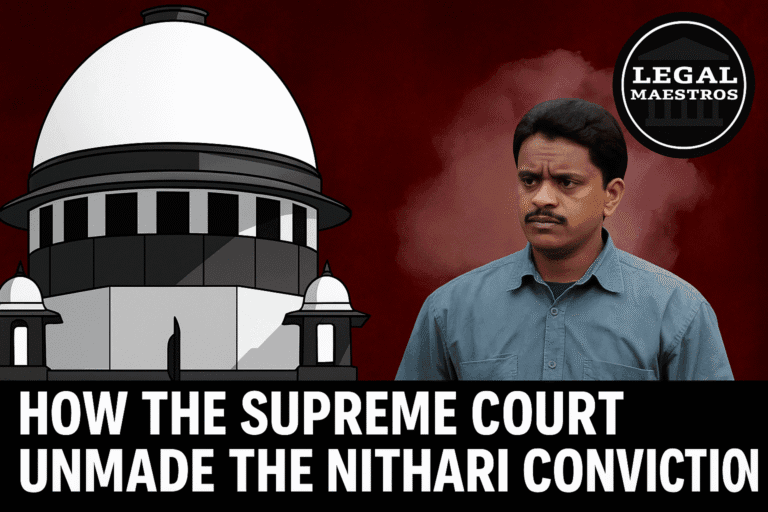
This case of Shyam Lall v. . was decided by the Supreme Court of India. The case of Shirram General Insurance Co. Ltd. and others, Civil Appeal Nos. 5177-81 of 2022, which concerns the liability of an insurance company regarding an accident involving a utility vehicle. The issue presented in the case is that, was the vehicle insured as a goods vehicle and thus limited in its use, or was a utility vehicle capable of carrying both passengers and goods? The ruling of the court helps to identify the difference between these types of vehicles and their insurance cover, and in the final decision the insurance company is found guilty of indemnifying the owner of the vehicle.
Brief Background of the Case.
The case was brought about by a road accident which occurred with the utility vehicle owned by the appellant, Shyam Lal, and led to five claim petitions. The appellant appealed a High Court order which had ordered a pay and recover order against the insurance company, Shriram General Insurance Co. Ltd. The High Court had determined that the utility vehicle could not carry passengers because of a certain limitation contained in its insurance policy as stipulated in the “Limitation of Use” clause.
The appellant contended that the utility vehicle was capable of carrying passengers and goods, and the clause on the utility of the vehicle was restricted to goods vehicles which was not the case in this instance. The vehicle had a seating capacity of four passengers and the driver indicated this on the registration certificate and the contract for carriage permit for the vehicle (4+1). The claimants were the legal representatives of the deceased, some of whom were occupying the vehicle and the other pedestrians at the accident site.
For any queries or to publish an article or post or advertisement on our platform, do call at +91 6377460764 or email us at contact@legalmaestros.com.
The insurance company, in its turn, argued that the passengers had not been covered by the policy. They indicated that not all of the dead were the owners of the goods or their agents. The company also claimed that it had killed nine people, a sign of overloading and. In its preliminary verdict, the Tribunal had found negligence by the driver of the utility vehicle and the vehicle was, in fact, covered by a valid package policy with the insurance company.
What is the Utility Van and what is its purpose?
One of the main issues in this appeal was the type of vehicle. The Certificate of Registration, which classified the vehicle as a Utility Van with a 5-seat capacity was also discussed by the Supreme Court including the driver. The vehicle was issued a permit for a carriage that carried five passengers, but still it was referred to as a contract carriage permit. The court invoked the Motor Vehicles Act, 1988 which describes a contract carriage as a vehicle that is used to transport passengers against a fee or reward, as opposed than a goods carriage which is used only to transport goods.
It was observed by the court that in the package policy of the vehicle under consideration, a Mahindra and Mahindra Bolero Camper Utility DC, 2WD, BS2 that the vehicle had a seating capacity of 4+1, including that of the driver, and the vehicle was intended to carry both passengers and goods. According to these documents, the court decided that the vehicle was not covered as a goods vehicle and thus the limitations as to the use clause, which constrains carriage of goods, were not applicable.
For any queries or to publish an article or post or advertisement on our platform, do call at +91 6377460764 or email us at contact@legalmaestros.com.
Admission and Liability of the Insurance Company.
The evidence of the Branch Manager of the Insurance Company was also subject to review by the Supreme Court. The manager told the court that the insurance policy was written after considering the registration certificate of the vehicle data which classified it as a Utility Van with a seating capacity of 4+1. The manager also testified that there was no recital in the policy document that the premium for the passenger was not charged.
Moreover, the manager clearly acknowledged that a utility van is a car whose half of its body is occupied by goods and the other half is in the front with passengers. This confession was paramount, because it went against the defense that the insurance company gave in that the vehicle was solely a goods vehicle and no passengers were insured. The court established that there was an understanding that the package policy was being issued on the condition that the vehicle was capable of transporting four passengers other than the goods. Therefore, the insurance company was not in a position to escape its duty to indemnify the owner.
Allegations and Final Verdicts Overload.
Another issue that the court discussed was the overloading claim of the insurance company with the number of claim petitions and the claim of 9 deaths. With the evidence, the order delivered by the Tribunal has shown that besides the passengers in the vehicle, there were other pedestrians who were hit and dragged down in the process of the accident. One of the eyewitnesses known as PW2 had stated in his testimony that he had counted four occupants in the vehicle prior to the accident and the insurance company could not correlate this testimony during their cross-examinations. The court thus rejected the overloading argument as one of the claims was that of a pedestrian.
For any queries or to publish an article or post or advertisement on our platform, do call at +91 6377460764 or email us at contact@legalmaestros.com.
The order of pay and recover ordered by the High Court was set aside by the Supreme Court which held that, the total liability was entirely on the insurance company. The court reinstates the original order of the Tribunal with one particular modification. In a different but directly related argument, the court ordered that in one of the claim petitions (MACT Case No. 134 of 2014), the Tribunal should offset one third of the calculated loss of income compensation as personal expenses and then pay out the figure. This conclusion supported the fact that the insurance company had a duty to abide by the conditions of the policy as issued especially in situations where the insurance policy and the vehicle documentation clearly showed that it was a utility van with the capacity to carry both goods and passengers. The appeals were granted and the decision of the High Court was overturned.






![Research Assistantship @ Sahibnoor Singh Sindhu, [Remote; Stipend of Rs. 7.5k; Dec 2025 & Jan 2026]: Apply by Nov 14, 2025!](https://legalmaestros.com/wp-content/uploads/2025/11/Gemini_Generated_Image_s0k4u6s0k4u6s0k4-768x707.png)
![Karanjawala & Co Hiring Freshers for Legal Counsel [Immediate Joining; Full Time Position in Delhi]: Apply Now!](https://legalmaestros.com/wp-content/uploads/2025/11/Gemini_Generated_Image_52f8mg52f8mg52f8-768x711.png)